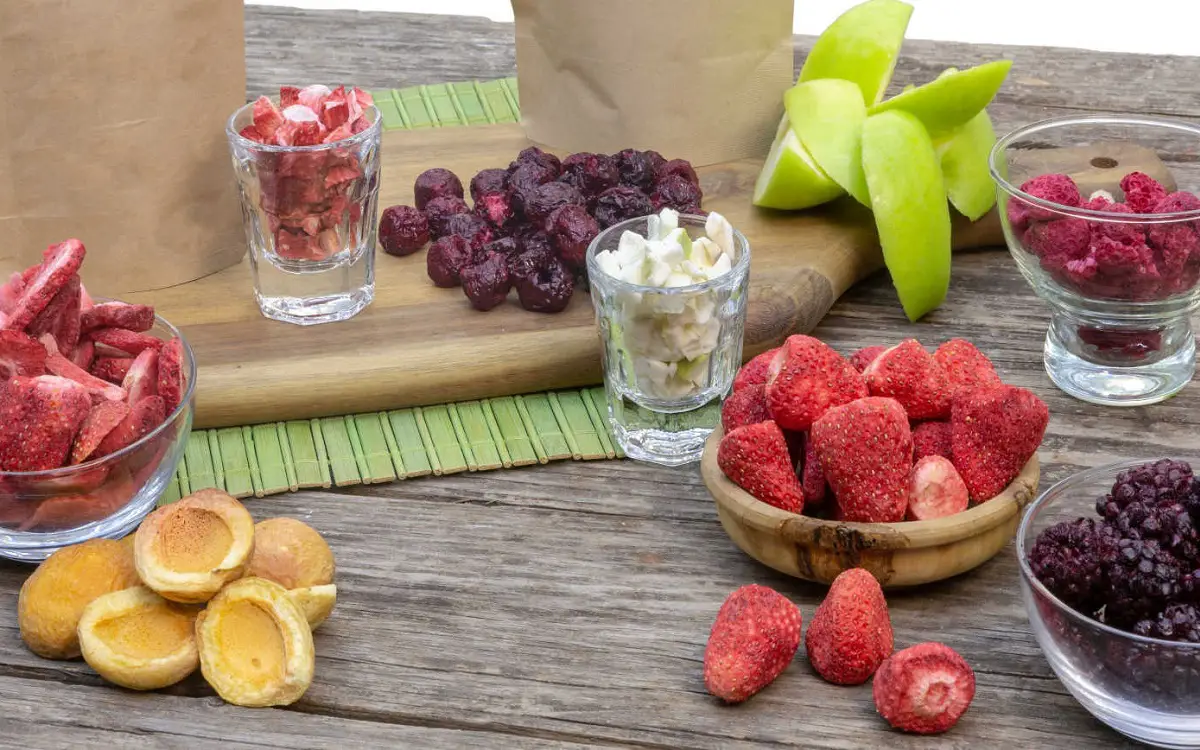SHTFPreparedness may collect a share of sales or other compensation from the links on this page.
Welcome to the fascinating world of freeze-drying! You have probably heard of freeze-dried food at least once in your life. Let’s get to the bottom of what it is.
Well, to begin with, it’s an amazing canning technology. It not only preserves the food’s nutritional value, It primarily captures its natural flavors and textures.
Freeze drying is a process that leaves no moisture in products. The products themselves remain in a frozen state. What result do you get? For storage and tasty products.
You can store them for a long time without losing their original qualities. Opens up a wide range of possibilities for both cooking enthusiasts and outdoor enthusiasts. But how do you achieve such a result?
In this text, we will examine how to freeze dry food. The main thing is that you will learn the methods you can use for this technique.
So, get ready to enhance your cooking skills. You will experience the magic of preserving perfection with the help of freeze-drying services.
How Does Freeze Drying Work?

Freeze-drying is a sophisticated method of canning. No more moisture will be left in your food, but there will be no significant damage.
So it will have the same structure and nutrients, but you can preserve such a product much longer. The process involves several basic steps.
Each of them ensures that the quality of the product is successfully preserved.
- Freezing – The food is first frozen at extremely low temperatures, typically below -40°C (-40°F). Freezing solidifies the water content within the food.
- Vacuum chamber – The frozen food is then placed in a vacuum chamber. In this low-pressure environment, the process takes place. It is freeze-dried food, which you can accomplish even at home with the right equipment. It is where the ice changes from a solid to a gaseous state, bypassing the liquid stage. This sublimation process gently removes the ice crystals from the food.
- Condensation – During the sublimation process, water vapor will collect and condense back into ice. All this will take place on a separate surface.
- Final drying – Next, the products undergo further drying. As a result, you will get products without any remaining moisture. It will ensure their long-term stability.
As a result, freeze-dried products have minimal shrinkage. They have a light, crunchy texture.
And most importantly, freeze-dried foods retain their nutritional value and natural flavors. These characteristics make these products the ideal choice for:
- Backpackers
- Campers
- Emergency food supplies
Freeze-Dried vs. Dehydrated Food

Food preservation technologies such as freeze-drying and dehydration are also common. Their techniques and consequences, however, differ.
Freeze-Dried Food
- Process. Freeze-drying involves freezing a product. The moisture will be removed from the food by freeze-drying it in a vacuum.
- Preservation. The low-temperature process preserves more nutrients. Freeze-drying will provide you with more flavor and texture than other methods.
- Rehydration. Freeze-dried foods quickly rehydrate when exposed to water. They quickly regain their original appearance and flavor.
- Weight and Volume. Freeze-dried food is lighter and takes up less space due to removing most of the water content.
Dehydrated Food
- Process. Dehydration is the slow removal of moisture from foods. It works by exposing it to heat, usually using ovens or dehydrators.
- Preservation. You may lose some nutrients in the process of drying at higher temperatures. The texture of your food can also change a lot.
- Rehydration. Dehydrated foods take longer to rehydrate. They may also not fully regain their original texture.
- Weight and Volume. Dehydrated foods are much lighter and more compact. But you may notice a certain amount of moisture in them. They are, therefore, less suitable for storage than freeze-dried food.
How Long Does Freeze-Dried Food Last?

Before you think about how to freeze dry food, we recommend that you know its shelf life.
You can recognize freeze-dried foods due to their exceptional shelf life. It makes them a reliable choice for long-term storage. Let’s answer this briefly first.
You will have a lengthy shelf life with proper preparation, packing, and storage. Such items can be stored for 20 to 30 years or even longer.
The impact of moisture is responsible for the lengthy shelf life. It acts as a barrier against bacteria, yeast, and mold growth. And these three elements are the primary causes of food deterioration.
Want to maximize the longevity of freeze-dried foods? Then we recommend storing them in airtight containers. Or you can put them in mylar bags with oxygen absorbers.
These are the ones that prevent moisture and air, the worst enemies of freeze-dried food. Also, remember to store them in a cool, dry, dark room.
It is an important condition to preserve their quality for a long time. The most important thing is to inspect and rotate your emergency stock regularly.
This way, you can always have a fresh and reliable supply when needed.
Freeze-Drying Methods

In the world of food, freeze-drying is a remarkable method. It can preserve various foods’ nutritional values, flavor, and texture. Many people will wonder how to freeze dry food.
Some think it is extremely difficult. But that pays for the art of freeze drying; you only need to understand the different methods you can use to achieve this wonderful preservation process.
In this section, we will look at several methods for freezing food. You will learn how to turn perishable ingredients into long-lasting and delicious food.
We’ll unravel the cells of each method. And we’ll provide valuable information for choosing the best method to freeze dry food at home. Let’s dive into the world of freeze-drying methods!
Freeze-Drying Machine
The first option is to utilize a lyophilizer, which is a freeze-drying machine. It is a complicated method of freeze-drying. Manufacturers create it to make the canning process easier by carefully manipulating it.
The freeze-drying plant consists of three main parts. There are three of them: the freezer, the vacuum chamber, and the condenser.
Place your food in the freezer to begin the process. The gadget will then freeze your meals at extremely low temperatures. After that, the frozen food is moved to a vacuum chamber.
It will directly convert the ice to vapor. After that, the vapor is collected and condensed in a condenser. It reverts to solid ice.
The machine has precise phase control. Therefore, it removes moisture from the products. The result is light, storage-resistant products. At the same time, they have minimal loss of nutrients and flavor.
Home Freeze Dryer

A home freezer dryer is a compact and easy-to-use freeze-drying method. It will allow cooking enthusiasts to preserve their favorite foods.
People have developed this machine to mimic the industrial sublimation process. But only the home machine works similarly. And the only difference is the amount of freeze-dried food at home.
The process will start when you place the prepared food in the freeze-drying chamber. It will freeze your food at extremely low temperatures. Then, in the chamber, it will happen.
The frozen water will sublimate and turn into steam. The vapor is then captured and condensed into ice on a separate condenser plate.
A home freezer dryer is a great option. Want to create your own freeze-dried snacks? Or preserve seasonal produce? Or maybe go out and prepare food supplies for emergencies? Then this option is right for you.
Freeze-Drying by Hand

Thinking about how to freeze-dry food without spending much money on equipment? Then manual drying may be an option for you.
Of course, you should realize that it does not have the same level of precision. But this method can also give satisfactory results.
All you need to do is place the product evenly on a tray. Then, you need to freeze them in a regular freezer. After freezing, transfer the products to a vacuum container or bag.
By hand, remove the air from the bag as much as possible. You need to create a vacuum. Over time, the frozen water within the food sublimates, turning into vapor. And you will have the food dry.
Freezing and drying by hand requires attention and supervision. But it can be a useful way to preserve seasonal fruits, vegetables, or home-cooked meals.
It’s a pretty practical approach without a big investment.
Liquid Nitrogen Freeze-Drying

Freeze-drying in liquid nitrogen is an advanced and specialized method. In this method, people freeze foods very quickly instead of using normal temperatures.
You can do this by using liquid nitrogen. It has an extremely low temperature of -196°C (-321°F).
You need to put the food in a container. Then add liquid nitrogen to it, which will cause the moisture to freeze quickly.
After freezing, transfer the container to a vacuum chamber. The frozen water will undergo sublimation and leave the product.
Freeze-drying with liquid nitrogen is often used for fragile or sensitive substances. However, you should know that you cannot freeze dry food at home with this method.
You need special equipment and experience for this method. Working with liquid nitrogen is dangerous.
Cryogenic Freeze-Drying
Cryogenic freeze drying is also called cryogenic freeze drying. It is an advanced method of freeze-drying. This method assumes that you will be using cryogens.
These are substances that are extremely cold. This method is especially suitable for preserving fragile and heat-sensitive substances.
In this drying method, the material undergoes cryogenic temperatures. These temperatures can be achieved using liquid nitrogen or carbon dioxide. This results in rapid freezing.
The frozen material is then usually transferred to a vacuum chamber. There, the cryogenics will undergo sublimation.
This process effectively removes moisture from the material without using high temperatures. You can often find this drying option in industrial applications.
It allows you to preserve the original structure and properties of the material. However, you cannot use this method of freeze-drying food at home.
You will also need special equipment and experience to perform it.
Vacuum Chamber Freeze-Drying

Vacuum chamber freeze-drying is the basic method most drying processes use. This method can be used for industrial, home, and laboratory applications.
It involves a combination of controlled freezing and sublimation. But it comes from a depressurized vacuum chamber.
Freeze dry food by placing the canning product in a vacuum chamber. Then, the temperature drops, and the material freezes.
Then, the vacuum pump evacuates the chamber, creating a low-pressure environment. When the pressure drops, the frozen water sublimates into vapor.
The vapor is subsequently captured and condensed, leaving the material thoroughly dried. Freeze drying in a vacuum chamber is quite popular in various fields.
It is because it preserves the structure of the material, its flavors, and its nutrients. At the same time, it achieves long-term stability.
Spray-Freeze-Drying
When asked how to freeze-dry food, spray freeze-drying is not the best option for the home. This method is most commonly used in the pharmaceutical and biotechnology industries.
This method offers a combination of aspects of spray drying and freeze drying. It is how you achieve specific conservation goals.
In this drying method, the material is sprayed into small droplets. It requires the use of a high-pressure nozzle or other spraying methods.
You can then watch as the droplets are quickly frozen using liquid nitrogen. After freezing, the material is moved to a vacuum chamber, where sublimation occurs.
This method is particularly useful for preserving temperature-sensitive substances. You can create powders with controlled particle sizes and properties.
The resulting powders often have improved recovery characteristics. This makes them valuable for various pharmaceutical, inhalation, and biotechnological applications.
Final Thoughts
Freeze-drying is an uncommon canning procedure. It offers a whole new universe of food preservation and enjoyment possibilities.
Whether it’s the simplicity of a home freezer dryer or the precision of a vacuum chamber, each approach has distinct advantages for fulfilling various purposes.
Freeze-dried foods are a popular choice for culinary enthusiasts and industrial businesses due to their ability to preserve nutrition, flavor, and texture while maintaining a lengthy shelf life.
By using freeze-drying, we may enjoy seasonal delights all year. You may prepare light and healthful outdoor dinners. You can also ensure that you have the appropriate supplies in an emergency.
Reference articles:
















